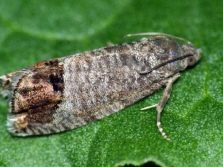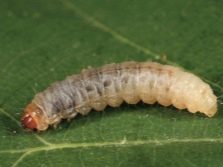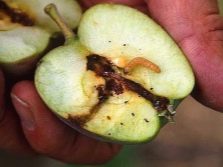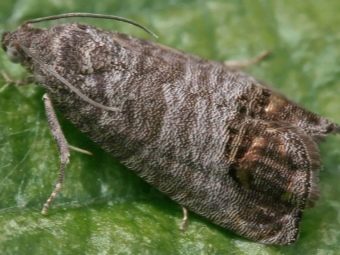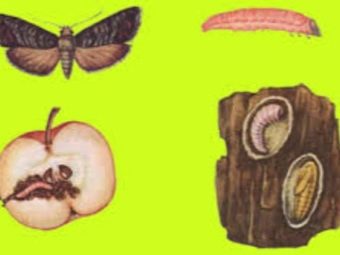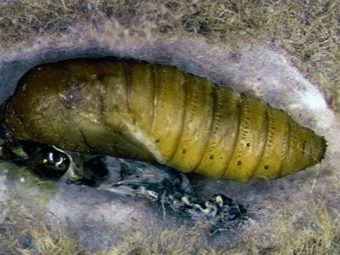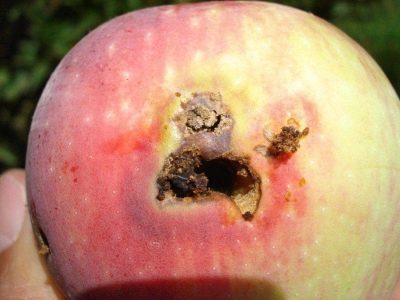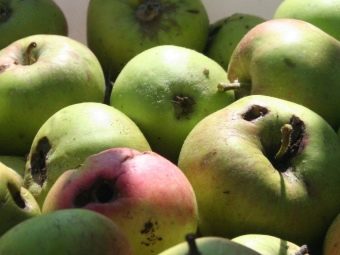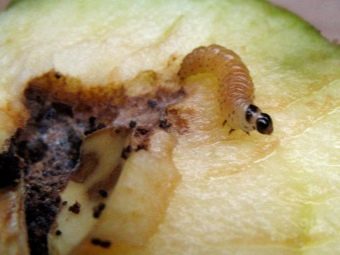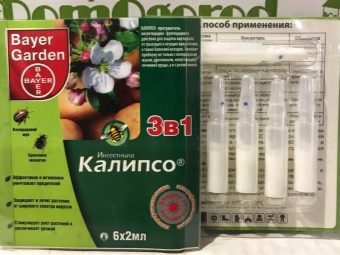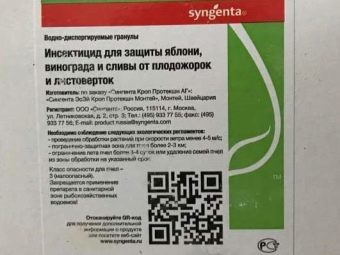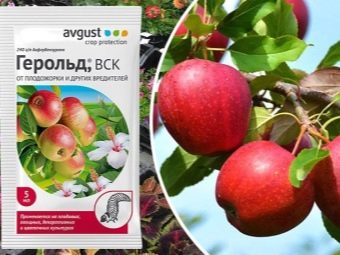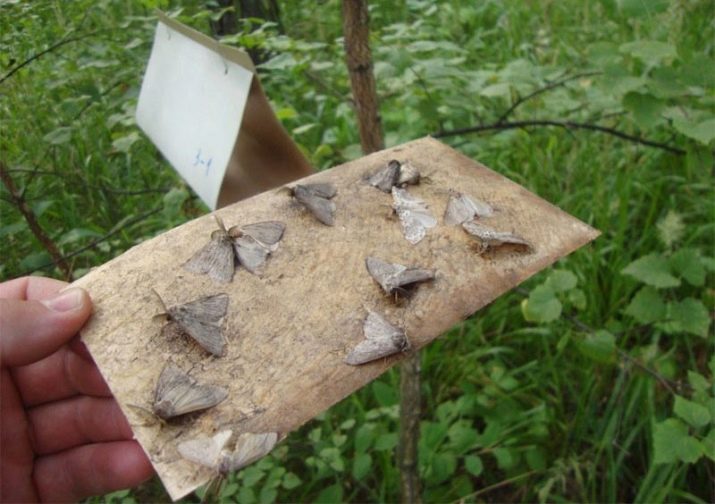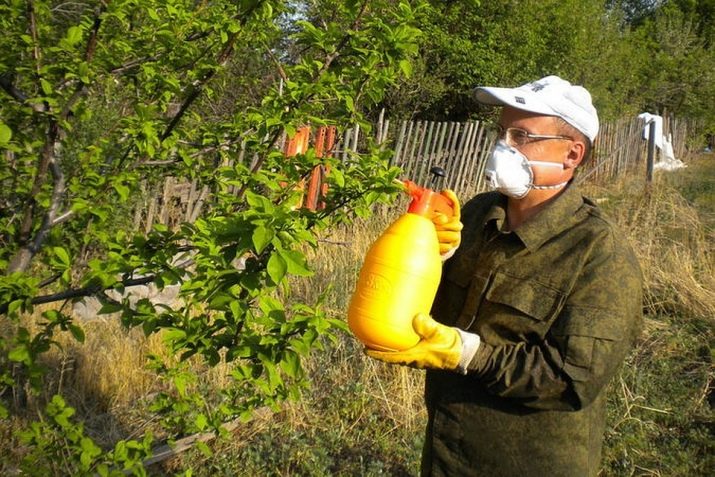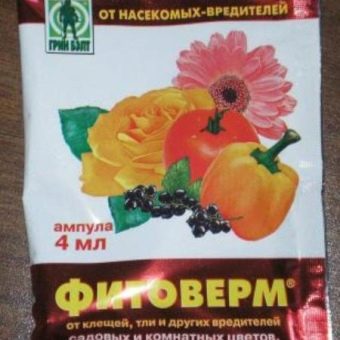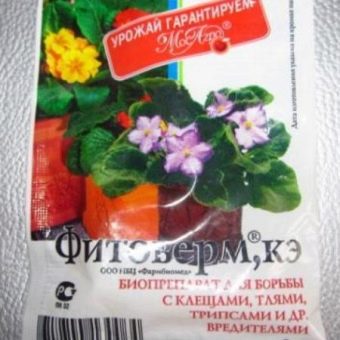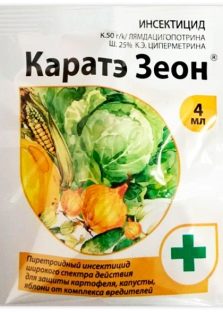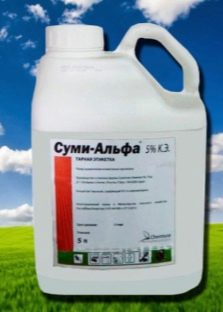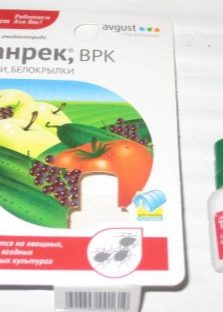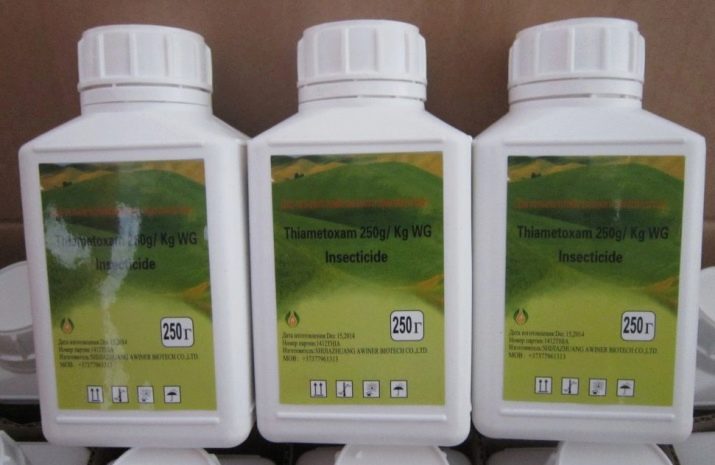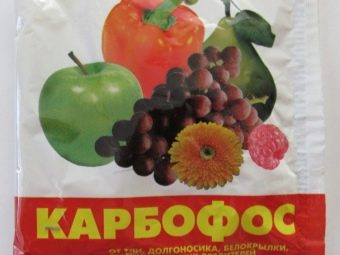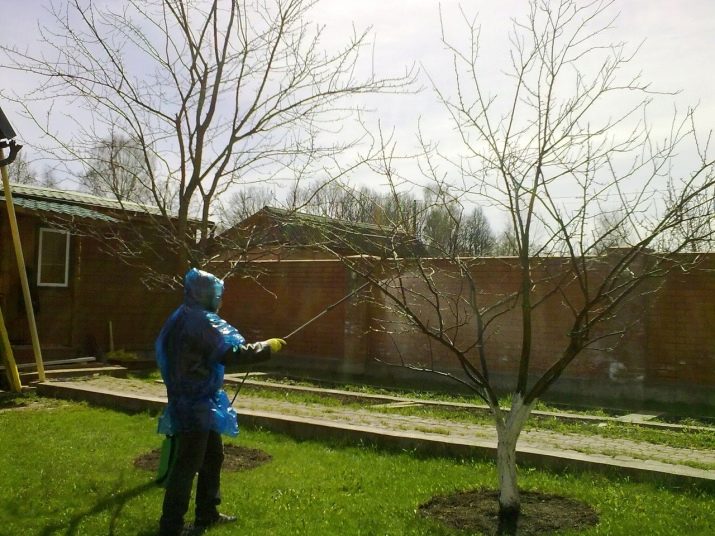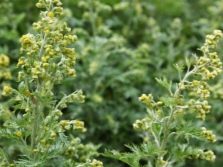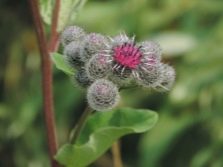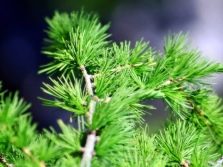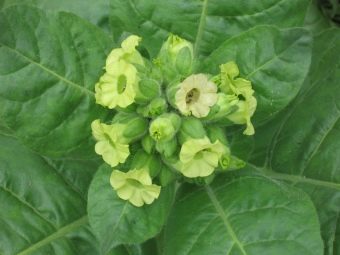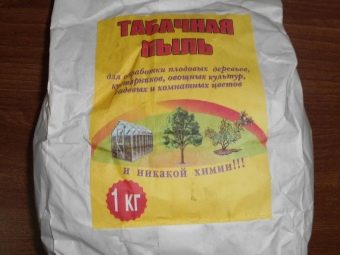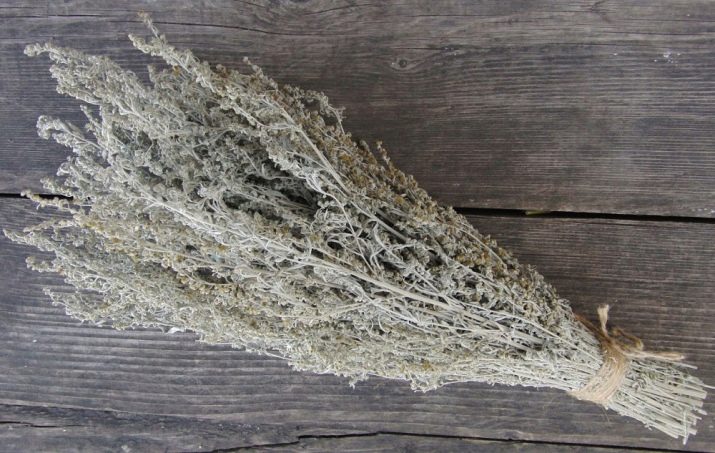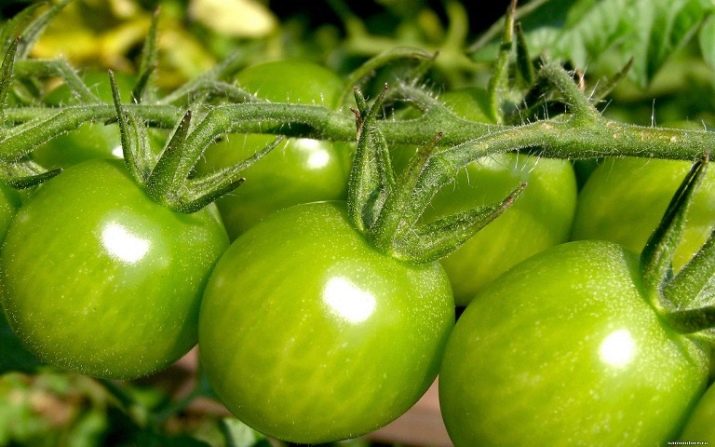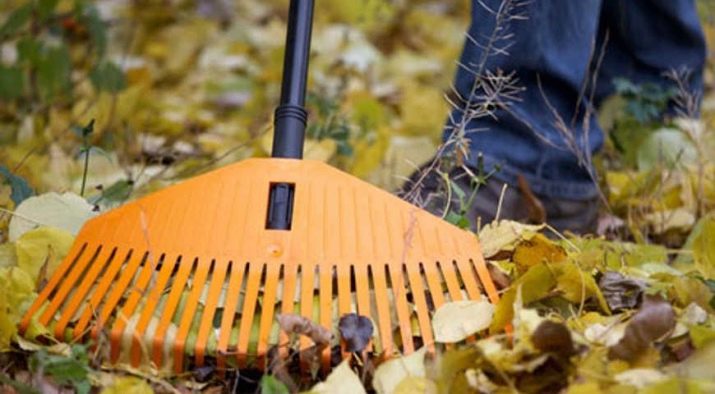Methods of dealing with moth on an apple tree
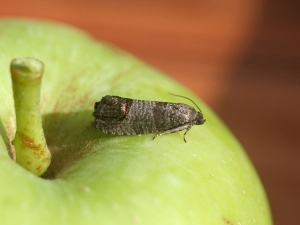
Garden fruit trees, even with proper and proper care, often suffer from the attacks of various insects that cause harm to the plant and the crop. In the list of such insect pests for an apple tree, the codling moth should be distinguished, which can cause many problems for the gardener with the crop. Therefore, it is important to have an idea about this pest and how to combat it.
Pest description
The codling moth refers to insects that pose a great danger to garden and fruit crops. The butterfly lives and breeds in different latitudes, so apple orchards often suffer from its attacks. While the moth has not yet transformed into a butterfly and is a caterpillar, it feeds on a green mass of trees, the pulp of fruits, destroying them at the stage of ovaries. In the case of the presence in the garden of a large number of pests, as a rule, the culture is doomed to death, because insects can spoil and destroy almost 100% of the entire fruit harvest.
The pest is characterized by the ability to produce about three generations of larvae in one season, so the issue of timely protection from the codling moth on an apple tree is very acute for a gardener in the case of growing several plants or on a large scale gardening scale. The second generation of pests is the most dangerous for fruit crops.
The moth is a caterpillar, which eventually becomes a rather large butterfly. The lepidopteran insect prefers to lead an active lifestyle at night, which complicates its timely detection at the site. Usually the presence of the pest is detected even after the appearance of the carrion, consisting of spoiled fruit. In addition, the butterfly has a very inexpressive wing color, due to which it is perfectly hidden among the branches and leaves.
The codling moth is one of the largest species of fruit pests - the wingspan of an adult individual can reach about 2 centimeters. For reproduction, the butterfly leaves its shelter at night, this period falls on the phase of flowering plants in the garden. The length of time when the butterfly produces offspring is about 1.5 months. Insect larvae lay on young foliage, shoots and fruits.
Eggs are rather small, reaching an average of one millimeter, so finding them is also quite problematic. An adult seed moth can lay over hundreds of larvae, of which caterpillars soon emerge. Within 2-4 weeks, the caterpillars actively destroy the culture, after which they enter another phase of growth, therefore they go deep into the soil or bark of the plant, where the process of cocoon formation takes place for the next wintering. In the ground moth can go even 10 centimeters. In addition, the pest can winter in the fallen leaves, in rooms equipped for storage harvested from gardens and orchards. Pupation occurs in the spring, since for this the pest needs an air temperature above +10 degrees.
In the summer and before the arrival of autumn, the codling can be found both in the developmental stage of the caterpillar and in the form of a butterfly. Butterflies of the second and subsequent generations are capable of reproduction during all summer months, which complicates their complete extermination at the site.
However, the pest is very sensitive to weather conditions, especially as regards drought and too high air temperatures. In such situations, when the humidity on the street drops below 30%, the caterpillars may die on their own.
What harm does it do?
Today it is impossible to meet in the nurseries or in the garden varieties of apple trees that are resistant to this pest. In addition, experienced gardeners and gardeners with many years of experience noticed that the fruits with tasty and juicy pulp are of most interest to the pest, unlike crops whose crops are processed into juices or canned fruit products.
Only appeared moths in the caterpillar stage destroy only the leaves, and after 10-14 days they are able to penetrate into the apples.
It is necessary to highlight the main scale of damage that causes pest apple crops:
- due to the presence of a pest on the plant, the fruits do not go through the full stage of aging, and already damaged ones fall off;
- even minimal damage to the fetus leads to rotting processes, so apples may not be suitable for consumption;
- after the fruit falls to the ground, the moth leaves the damaged apple and again moves to the fruit crop;
- one caterpillar can destroy at least three apples;
- with a large number of insects, you can lose almost 90% of the total fruit yield.
Adults individually lay their eggs, one on each piece of apple, so that the hatched larva has enough food to feed and grow. If there are other fruit crops on the plot, the moth will destroy not only the apple tree, but also peach, plum and even apricot and walnut, which increases the scale of harm and complicates the process of extermination of the insect pest.
Processing time
To protect against the pinworm, it is customary to process the culture with various compositions and solutions. Get rid of the pest will help folk remedies, as well as chemicals. The main thing in this matter is to observe the terms of work with one or another composition, focusing on the phases of growth of culture and seasonality. In addition, the climate in the region where the apple is cultivated remains important, in light of which it is quite difficult to select the most accurate dates for spraying the plant.
As for the spring work on preventive treatment, emphasis should be placed on organophosphate compounds, which will allow to destroy even the younger generation of moths in the form of small caterpillars. Among the list of store trains worth highlighting the "Calypso" or "Zolon." This time of early spring processing work should be carried out before the beginning of the flowering phase of the plant in the garden.
After flowering culture activates adults, which have already become butterflies. At this time it is necessary to focus on such compositions as "Insegar" or "Gerold". Such drugs can have a detrimental effect on the development of insects, which is important in this period, because the females will lay eggs on the shoots and leaves. As a result, the larvae will be in contact with the poisonous surface, which will lead to the death of the insect. For the southern regions, the favorable time for work falls on the 13-14 day after the completion of the apple flowering phase with the re-processing in 1.5-2 weeks. The third and subsequent runs at intervals of 2-3 weeks.
In the spring, the culture can be protected with a complex of drugs against pests, in addition with toxic substances using sticky or ferromone belts.
During the ripening of summer and autumn fruits, for example, in June-August, the pinwort should be disposed of with the help of bio-compositions and decoctions of herbs. Synthetic drugs at this time can not be used. In the autumn months after the leaf fall, you need to spray the fruit crop and clean the shoots and stem with the help of a sparing scraper.
The frequency of processing crops from the moth depends on how many times the insect is able to produce offspring in a given area. In cases where a butterfly produces three or more generations of caterpillars, it will take about 5-7 treatments. Spraying should be carried out in cloudy weather, but wind should be avoided.
How to fight?
For the destruction of the pest today there is a large selection of store preparations, as well as compositions used by gardeners to combat pest for several generations. Both those and other means demonstrate high efficiency in work, therefore they can be used in combination or as an independent poison for fighting with the butterfly.
Preparations
Apple trees are usually treated with chemicals based on organophosphates, but you can also kill the codal moth with neonicotinoids and pyrethroids.
Among the means with a complex action, we can distinguish "Fitoverm". The components of the drug are able to penetrate the tissues of the caterpillar after it has eaten the treated fruit or foliage, causing rigor mortis and death.
Aversectin-C has a prolonged effect, therefore its use should be abandoned in the fruit loading phase.
Among the most qualitative and proven pesticides in practice can be distinguished preparations "Karate-Zeon", "Sumi-alpha", "Aktellik". The non-nicotinoids “Tanrek”, “Confidor” and “Fastak” are also effective.
Synthetic pyrethroids can be used no later than a month before the beginning of the ripening phase of apples, since their constituents penetrate deeply into the green mass and fruits. The result of the use of such tools is the complete destruction of the tracks.
The use of mixed insecticides is shown in the case when fruit plantations were sprayed without any scheme, and the same composition was used as a means to kill pests. For such situations, one should combine thiamethoxam and “Chlorantraniliprol” or pick up another complex of toxic substances.
Among organophosphate insecticides, it is worth mentioning Karbofos or Dichlorvos. Organochlorine compounds are less harmful to humans and animals, since they emit minimal amounts of toxic decomposition products. Such compositions have recently been very popular in the fight against moths.
With regard to the technology of processing fruit crops by chemical means, preference should be given to apparatus capable of reproducing drops from 0.23 to 0.53 mm. As a result of working with the device, a kind of mist will form over the plant, which will create a good enveloping effect on the foliage, as well as save on the consumption of drugs. In addition, such drops practically do not spread to unwanted places and areas by the wind, which excludes ingress of poisonous compounds on other plants in the garden.
Folk remedies
For a long time period of struggle with the codling moth, gardeners and gardeners have tried a lot of means of its destruction. Among this list, a special place is occupied by compositions that are made independently and less harmful to humans and garden crops. In most cases, gardeners and gardeners resort to treating plants with decoction or infusions on the basis of various herbs. Among these plants is wormwood and burdock. Also popular infusions based on needles and processing of tobacco dust and its decoction.
The initial processing of the crop to repel insects is usually carried out before the flowering phase of fruit plantations. The second and subsequent perform with an interval of 2-3 weeks.
For a long-lasting spraying effect, it should be carried out in the evening, in dry and calm weather.
Tobacco decoction
Prepare it according to the following technology:
- for the preparation of 0.5 kilograms of dry matter diluted in 10 liters of water, the drug should be infused for 2-3 days;
- after which the agent is brought to a boil and boil for about two hours;
- add another bucket of water.
Before processing in the tool you need to enter 50 grams of soap. Such a composition is used in the period when the phase of birth of caterpillar caterpillars begins. Due to the fact that tobacco is toxic, work with the composition should be carried out while observing personal safety measures.
Based on wormwood
Prepare a decoction as follows:
- kilogram of grass must be poured with a liter of water and boil for at least half an hour;
- after cooling means enter into it a bucket of water.
On the basis of red pepper
For the destruction of the moth moth, the folk drug is also effective, the preparation of which takes place according to this recipe:
- 0.5 kg of sharp pods are poured with two liters of water and boiled in a closed container for 60 minutes, after which the infusion should stand at room temperature for at least two days;
- Before processing the cultures, filter the composition and add a soap solution.
Tomato Based
Effective for combating moth folk drug based on tomato. To prepare the tool, it is necessary to grind about 4 kilograms of tops, stalks and green tomatoes and pour them with ten liters of water. The resulting composition is boiling for 30 minutes. Before work, it must be filtered and diluted with water in the ratio of 3 liters of infusion to 10 liters of water with soap.
However, as practice shows, in order to exterminate the codling moth, it is necessary to apply an integrated approach, comply with all rules relating to the care of plants and be sure to carry out preventive treatment.
A big plus in resolving the issue with the pest in the garden will be a joint fight with neighbors, otherwise the treatment with poisons will only be temporary, and the pest from another site located nearby will eventually return to your site.
Preventive measures
In order to prevent the spread of the pest in advance or to avoid the reproduction of individuals, one should resort to preventive measures. The main ones are discussed below.
- In order to prevent the penetration of the butterfly into the plot, one should timely dig up the soil in the near-stem circle. These works should be carried out in the autumn months. Thus you can get the cocoons with caterpillars, which remained in the ground for the winter. When raising them to the surface, the first cold will destroy insects.
- With the arrival of heat and deep autumn, it is necessary to clean and inspect the bark on the branches and trunks of the apple tree. Old sites and places in which there may be pupae should be deleted. All bark and carrion must be burned.
- A good preventive measure will be the landing next to the fruit plantations of grassy crops, which will attract insects to themselves, which destroy the caterpillars moths. Trichogram is considered the natural enemy of the moth.
- When settling in the garden, feeders can be attracted to the plot of insectivorous birds, which will help to destroy the pest.
- The moth does not tolerate the smell of tomatoes, you can also plant mustard or dill nearby.
- In the summer months for the prevention of trees set trap belts, which can be made independently of fabric or cardboard.
- It is very important that the cultures in the garden are well-groomed and strong, in which case the plant will be able to withstand the attacks of insect pests.
- Competently formed and maintained balance in the garden will minimize the breeding of the moths, since most insects will be destroyed naturally, without the use of poisons. And additional spraying will be an effective addition to the protection of the crop from the pest.
- An important point is the removal from the site of carrion, fallen leaves and other plant debris, in which the caterpillars can settle for the winter.
The methods of dealing with fruit moth are described in detail in the video below.

